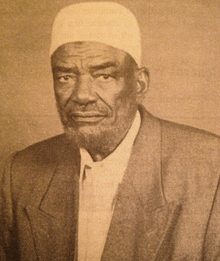Waqo Gutu
| General Waqo Gutu | |
|---|---|
 | |
| Native name | Waaqo Guutuu Usuu |
| Born |
1924 Odaa |
| Died |
February 3, 2006 (aged 81–82) Nairobi, Kenya |
| Buried at | Odaa |
| Allegiance |
Oromo Liberation Army United Liberation Forces of Oromia, Bale Rebel Movement |
| Years of service | 1960-1969, |
| Rank | General |
| Battles/wars | Dhombir War; Battle of Malka Anna, Battle of Harana, Battle of Meti, Battle of Rayitu[1] |
General Waqo Gutu Usu (1920 - February 3, 2006) was an Oromo rebel figure and leader of one of the earlier Oromo separatist movements; the Bale Revolt, which in the 1960s had fought against the feudalistic system in place in the Ethiopian Empire. He was elected chairman of the United Liberation Forces of Oromia in 2000. In 2006, Gutu died in a Nairobi hospital, survived by 20 sons and 17 daughters.[2]
Life
Little is known about his early schooling or ideological basis for his rebellion against Emperor Haile Selassie and the regimes that followed the monarch’s ouster and murder. Assessments of Wako Gutu vary greatly over his role as "founder" of Oromo separatism. However, according to historians, Waqo Gutu was ideologically and militarily trained by Somalis to initiate the Oromo separatism movement.[3]
According to Oromo community leaders in Nairobi, General Waqo Gutu as he was known was a symbol of Oromo resistance and initiator of their right to self-determination. According to Oromo accounts Gutu sowed the first seeds of rebellion in 1943 by acquiring arms to commence the struggle against Haile Selassie, and touched off a political and military struggle that lasted for decades. He fired the first shot in 1958 by slaying two policemen and together with Abdullai Usman Gutu proceeded to the jungle in 1962 to widen an armed resistance against Haile Selassie’s land policies in what is now Oromia Region, where most Oromo live. The next year, he attacked the Dhombirka battalion of the imperial army, inflicting heavy casualties.
His role in starting the Bale Revolt was almost accidental, according to one source. When a conflict over grazing rights between two groups of Oromo was ignored by the central government, after waiting in vain for three months Waqo Gutu "went to Somalia and brought back 42 rifles and two Thompson submachine guns."[4] Waqo's journey took place early in 1965; the revolt itself had been raging since June 1963 when Kahin Abdi openly defied the government in Afder.[5] An ill-timed attempt by the government to collect unpaid taxes from local peasants fanned the flames. At the end of 1966, about three-fifths of Bale Province was in turmoil. This peasant revolt ran from 1964 to 1970, stemming from issues involving land, taxation, class, and religion.[6] Waqo Gutu surrendered to the Ethiopian government 27 March 1970. The cost of the rebellion was minimal to him; he was given a villa in Addis Ababa and treated well by the Emperor. The local Oromo peasants lost tens of thousands of hectares, which was redistributed to Christian settlers who had fought against the rebels.[7]
With the eruption of the Ethiopian revolution, Waqo returned to Bale, and between 1975 and 1991, his guerillas controlled several towns in Oromia. He also visited several countries, including Somalia to raise funds with which to arm and galvanise the struggle.
In 1989 he established the United Oromo People Liberation Front (UOPLF) to join the struggle against the dictator Mengistu Haile Mariam. He joined the victorious Tigrayan People's Liberation Front (TPLF) of Meles Zenawi which had ousted Mengistu, but Waqo left the transitional government talks in 1992, claiming he had been betrayed by the TPLF.
In 2000 he formed the ULFO to unite the disparate armed and political groups fighting for the right to self-determination of the Oromo, and led as chairman from 2002 until he was taken ill and flown to Nairobi where he died after three months' hospitalisation. He was buried 11 February in his birthplace in the Bale Zone.
References
- ↑ Ademo, Mohammed. "Commemorating 50 Years of Oromo Struggle led by General Waqo Gutu". OPride.
- ↑ Lemi Kebebew, "The Father, Leader of Oromo Struggle Passes Away" (Oromia State Government website, accessed 6 October 2006)
- ↑ "Rebels and Separatists in Ethiopia" (PDF). Retrieved 2013-08-10.
- ↑ Marina and David Ottaway, Ethiopia: Empire in Revolution (New York: Africana, 1978), pp. 92
- ↑ Gebru Tareke, Ethiopia: Power and Protest: Peasant Revolts in the Twentieth Century (Lawrenceville: Red Sea, 1996), p. 140.
- ↑ Gebru Tareke, Ethiopia, pp. 125-159.
- ↑ Ottaway, Empire in Revolution, p. 93